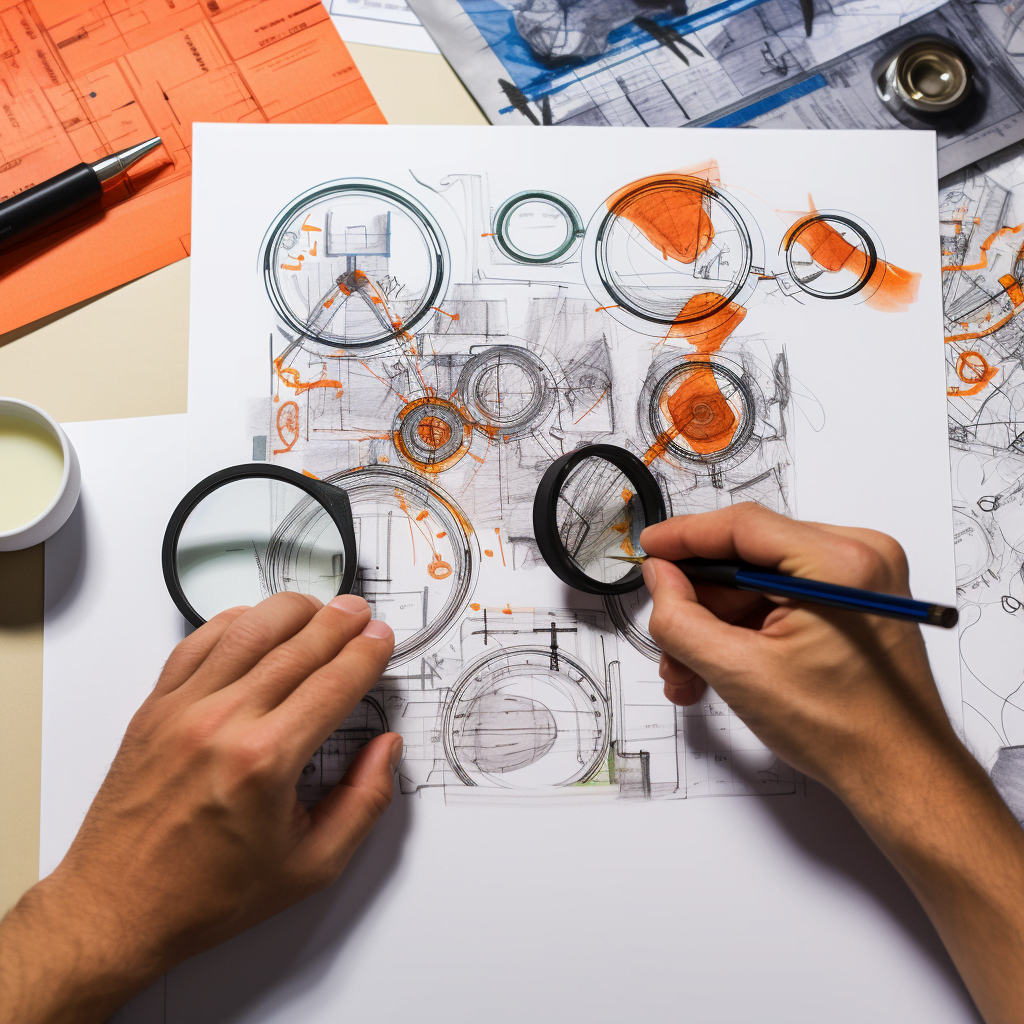The Gratifying Gamble of Testing in Design Thinking
Testing is crucial at the heart of design thinking. It’s where ideas undergo rigorous checks to exceed expectations and meet user needs. But how does one conduct user testing? Is it just about product viability?
As Steve Jobs said,
“Design is not just what it looks like and feels like. Design is how it works.”
User testing crafts a functional, user-friendly design that resonates with your audience.
In design thinking, testing is the final stage following empathising, defining, ideating, and prototyping, leading to a comprehensive understanding of users and design’s impact.
You’ve encountered design testing in life. Remember updating your phone’s OS or trying out a new app feature? That’s the result of diligent testing!
The testing and evaluation phase involves four steps: plan preparation, facilitator briefing, participant interaction, and data analysis. Usability testing and A/B testing provide valuable feedback on design performance.
To quote Thomas Edison,
“I have not failed. I’ve just found 10,000 ways that won’t work.”
Testing in design thinking refines ideas, triumphs over challenges, and paves the way to innovation.
Design Thinking Unplugged: Decoding the DNA of Testing

There is a method to the madness in design thinking, and testing is its backbone. It’s not merely a step in the process but the heartbeat that pumps life into your design. It transforms a beautiful design into a functional masterpiece that resonates with your users.
“People ignore design that ignores people.” – Frank Chimero
Testing, in essence, is the culmination of empathy, defining, ideating, and prototyping. It’s a litmus test, a reality check that measures the success of your design by how well it meets your users’ needs. But why test? What does testing bring to the table in terms of value?
Testing reveals the unexpected, opening up a dialogue between designers and users and serving as an opportunity to learn, iterate, and refine. It builds a bridge between an idea and its realization, between a thought and its manifestation.
Remember, the design thinking process does not end with testing. Instead, it circulates back to the beginning, tapping into the iterative nature of design thinking. It’s about exploring multiple approaches, taking a few steps back, reassessing, and pushing forward again. Each test is an opportunity to grow, improve, and innovate. In essence, the question isn’t why we test, but how could we not test!?
“The best way to predict the future is to design it.” – Buckminster Fuller
Testing is like a compass guiding a ship on a vast ocean. It provides direction, keeping the design process on track towards creating user-centred solutions. Emphasise on the testing methods and techniques to be used, making sure it is tailored to your users’ needs. Be it usability testing or A/B testing, let the needs of the user steer your choice of method.
More ideas for testing can be found in our article Design Thinking in Practice.
The Fine Art of Testing in Design Thinking
Moving from the prototyping stage into testing in design thinking demands an organised approach. The knowledge extracted from the prototyping stage serves as a guide for testing and facilitating solutions that genuinely resonate with users.
“Innovation distinguishes between a leader and a follower.” – Steve Jobs
The testing phase is not merely a tick-box exercise. It’s the stage where we translate insights from prototypes into user-friendly designs. This transition is not always smooth; it involves a steep learning curve. Yet, it’s this process that ensures our designs are not simply innovative, but also functional, intuitive, and engaging.
Let’s take an app, for instance. During the prototyping phase, we learn about user interactions, their expectations, their pain points. Enter testing, and we refine our prototype, seeking to eliminate these barriers and enhance usability. The results of the testing phase offer a mirror, reflecting the reality of our ideas, and giving us an opportunity to refine them.
Design testing methods vary, from usability testing that focuses on the effectiveness and efficiency of the design, to A/B testing, which presents users with two different versions of the design. These techniques reveal invaluable insights about how our design will be received by the user, shaping the final product to meet their needs.
Subsequently, the four-step procedure for testing with a user sheds light upon the process. Plan preparation, facilitator briefing, participant interaction, and data analysis – these steps unfold systematically, ensuring comprehensive and meaningful feedback.
“The details are not the details. They make the design.” – Charles Eames
Importantly, however, remember that testing is not the final stop in the design thinking journey. It’s a cyclical process; we revisit, reassess, and refine our designs, drawing from user feedback and continually striving for better solutions. Testing is a continuous conversation with our users, a dialogue that fuels innovation and fosters design thinking.
So, as you navigate the seas of design thinking remember, it’s not about getting it right the first time, but learning, growing, and improving with every test, with every user, and with every iteration.
A Masterclass in Design Thinking Testing

Delving deeper into the realm of design thinking, let’s unravel the process of testing, an integral and often misunderstood component. While we’ve touched on the importance of user testing in design thinking, what we need to understand is the ‘how’, the practicality of this stage.
Consider testing as your analytical lens, a tool to perceive your design from the user’s viewpoint. It’s not merely about identifying what works and what doesn’t, but rather understanding why certain elements resonate with users and others fall short.
“Design is not just what it looks like and feels like. Design is how it works.” – Steve Jobs
Testing in design thinking is a systematised procedure.
- The first step is plan preparation, where we define the purpose, scope, and methods for the impending test.
- Next is the facilitator briefing, where the facilitator is equipped with an understanding of the testing process, and prepared for participant interaction.
- At this stage, the participant, representative of your user, interacts with the design.
- The facilitator observes, listens, and learns.
- Lastly, we delve into data analysis, dissecting the acquired feedback and insights to shape our design.
There are various testing methods and techniques available, such as usability testing and A/B testing, each offering a unique insight into your design. Usability testing evaluates the design’s effectiveness and efficiency, while A/B testing allows for a comparative study, presenting users with two versions of the same design.
“Design is a solution to a problem. Art is a question to a problem.” – John Maeda
However, do not forget that design thinking is a cyclic process. Testing is not the endpoint, but rather a springboard that propels us back into the process, armed with user feedback and insights, ready to refine our design. The emphasis in design thinking testing is not just on the ‘what’ but significantly on the ‘why’. This approach ensures our designs are not just aesthetically pleasing, but also user-centric, intuitive, and functional.
The Art of Insightful Testing: A Deeper Dive into Design Thinking
Design Thinking is akin to a dance, an elegant interplay of creativity and structured analysis. At the heart of this dance is the testing phase, a critical point in the process where our innovative ideas confront reality, illuminated by the spotlight of user feedback.
“Good design is obvious. Great design is transparent.” – Joe Sparano
Imagine the process of testing as an analytical lens. With it, we gain a unique, user-centric view of our design and its functionality. This lens helps us to discern not just what works in our design but why it does. So, how do we go about it?
Leading on from the testing, we start to interpret the results. Her ewe follow the approach of:
- Understanding the data: Analyse the user feedback at both a macro and micro level. Understand how individual elements impact the design as well as its overall effect on users.
- Refining the design: Incorporate insights from testing to refine your design, making it more intuitive, functional, and engaging.
- Repeat: Testing is a cyclic process – once new features have been added or existing ones altered, it’s time to put the design back through testing and refine further.
Thus, with user feedback as our guide, we are able to traverse the intricacies of design thinking.
“Details make perfection, and perfection is not a detail.” – Leonardo Da Vinci
We may have gained valuable insights from our testing. With user feedback, we plunge back into the process, revising, refining, and improving. This constant revisiting is what ensures our designs aren’t just visually appealing but also user-centric, intuitive, and functional.

Frequently Asked Questions
What is testing in design thinking?
Testing in design thinking is the stage where ideas meet reality.
It’s an opportunity to evaluate your design solutions from the user’s perspective, identify what works and what doesn’t, and understand why certain elements resonate with users while others fall short.
How to do user testing in design thinking?
User testing in design thinking involves a systematic approach:
- Begin with plan preparation, defining the purpose, scope, and methods for the test.
- The facilitator is briefed to understand the process and prepare for participant interaction.
- The participant, who represents your user, interacts with the design while the facilitator observes and learns.
- Finally, delve into data analysis, using acquired feedback and insights to shape the design.
Why do we need to do user testing in design thinking?
User testing is pivotal in design thinking as it provides invaluable feedback from the user’s viewpoint.
It helps designers understand why certain design elements are effective and others aren’t, enabling them to create solutions that are not only aesthetically pleasing but also functional and intuitive.
What are the 5 stages of the design thinking process?
The 5 stages of the design thinking process are:
- Empathize,
- Define,
- Ideate,
- Prototype, and
- Test.
Each stage plays a critical role in understanding the user, defining the problem, generating solutions, and refining these solutions based on user feedback.
What is an example of a test of design?
A/B testing is a popular example of a design test.
It involves presenting users with two versions of the same design and measuring their responses, allowing designers to determine which version is more effective.
More can be found at: Design Thinking in Practice
What is testing and evaluation in design?
Testing and evaluation in design refer to the process of assessing a design solution from the user’s perspective.
It involves measuring the effectiveness, efficiency, and appeal of the design, and using the feedback to make necessary refinements.
What is the 4 step procedure for testing with a user?
The 4-step procedure for testing with a user includes plan preparation, facilitator briefing, participant interaction, and data analysis.
This systematic approach ensures comprehensive feedback, shaping the design to better meet user needs.
What are design testing methods?
Design testing methods include usability testing and A/B testing.
Usability testing assesses the design’s effectiveness and efficiency, while A/B testing allows for a comparative study of two versions of the same design.
More can be found at: Design Thinking in Practice
What are user testing techniques?
User testing techniques range from in-person observation to remote testing.
They can involve structured tests with specific tasks for users to perform, interviews to gain qualitative insights, or even surveys for collecting quantitative data.
References and Further Reading
Throughout this exploration into the testing phase of design thinking, we’ve consulted several notable resources. These include:
- Brown, Tim. “Change by Design: How Design Thinking Transforms Organizations and Inspires Innovation“. This book provides an in-depth look into design thinking.
- Knapp, Jake et al. “Sprint: How to Solve Big Problems and Test New Ideas in Just Five Days“. This resource is an essential guide to the sprint methodology in design thinking.
- Jobs, Steve. “Steve Jobs: The Exclusive Biography“. This biography provides an interesting perspective on Steve Jobs’ approach to design.
For those itching to delve deeper into design thinking, we recommend the following resources:
- “IDEO U – Design Thinking Online Courses“. These courses offer a comprehensive understanding of design thinking.
- “d.school: Institute of Design at Stanford“. This website provides a wealth of resources to enhance your understanding of design thinking.
Please remember to always verify the availability and accuracy of linked content as these might change over time.





0 Comments